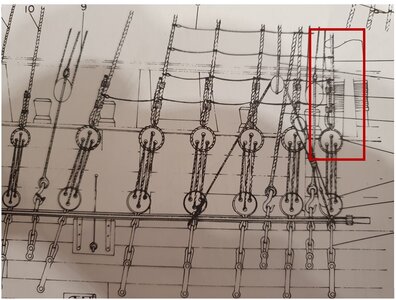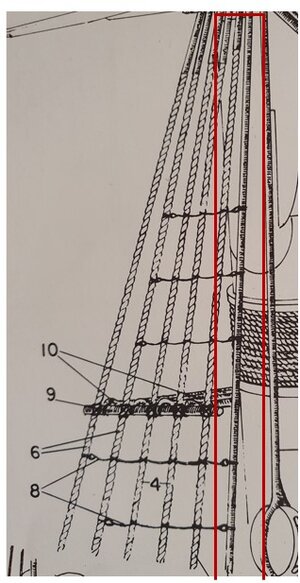- Joined
- Aug 30, 2020
- Messages
- 675
- Points
- 353

Is that the left hole on both sides of the ship, so one is towards the bow and one the stern.
 |
As a way to introduce our brass coins to the community, we will raffle off a free coin during the month of August. Follow link ABOVE for instructions for entering. |
 |

Is that the left hole on both sides of the ship, so one is towards the bow and one the stern.
Thank you Jim. All is clear concerning the crowsfeet now.Hello Trevor,
Crowsfeet were used to prevent the topsails blowing underneath the tops, they were fitted between the fore-edge of the tops and stay, These consisted of a number of ropes which were laced from holes in the edge of top and the euphroe. The euphroe was fixed to the stay with a simple tackle. Crowsfeet were always carried on the main and fore tops, and frequently also on the mizen top. Towards the end of the 18th century the crowsfeet disappeared
Here are some handy diagrams that should give you a bit more explanations of how the crowsfeet were laced.
View attachment 275182 View attachment 275183
View attachment 275184
I spoke earlier, I believe in another post, that the kit manufacturer foresaw only 10 holes for the crows feet in the tops and having already manufactured the euphroes and the holes in the tops according to the kit's drawings, I decided to leave them as they are. After deliberiations with myself, I decided that it would not have reflected authenticity. I took it upon myself, therefore, to blank off the existing 10 holes and drill 18 equi-spaced holes in the tops and to remanufacture the euphroes with 9 holes apiece.Hello Jim,
Many thanks for your response. So, for the sake of authentication, the ropes at the deadeyes should be stained to reflect their tarring. I will leave these ropes either a natural colour or stain them light brown.
On another subject, I have just completed the euphroes for the crows feet.
Would the rope tying these euphroes to the bowsprit have a block at its end or does the rope come straight off the euphroes down to the bowsprit?
Maybe the euphroes are considered to be the block itself and therefore not requiring an additional block. Che sa?
Trevor.
View attachment 274275
...the Shrouds themselves were wormed at the latest by the second half of the 16th century. The foremost shroud of each mast was wormed, parcelled, and served from the half of the 16th century on. From the middle of the 16th century in England (British), and from around 1680 on the Continent, the eye round the masthead was also served, initially as far as the seizing, but soon right down to just below the futtock stave. Serving at the lower end of the shroud, where it inclosed the deadeyes or the thimble of the rigging screw, first appeared during the 19th century.Another question regarding the rigging of the shrouds to the deadeyes.
I am serving the first rope on the port and starboard sides of each lower mast. Does the served rope go down to its deadeye and around it or would the serving stop before it reaches the deadeye? I am asking as it is proving quite difficult to mount the rope around the deadeye due to its increased thickness.
Trevor
Trevor, good afternoon.Thanks Jim, and a happy new year to you and your family.
My ship is mid-18th century, so no worming down to the deadeyes.
I am now looking in the various literature at my disposal to see where the worming (serving) actually finished. I haven't found any pointers yet, but I summise the worming would have finished somewhere between below the sails and the deck railings.
Trevor
Hi Jim,Here are the various diagrams\images to depict your question
View attachment 279752 View attachment 279753


They should always be black- specials treated , as they are nearly never taken down -only with change of mast parts etc. yea PART OF THE STANDING RIGGEN. the deadeyes on top SHALL always be aligned.I have a question relating to the rigging of the deadeyes at the shrouds of the lower and upper masts:
The colour of the standing rigging is usually black, while the running rigging is usually a light colour. I consider the rigging at the shrouds to be standing rigging. I stand corrected, if this is not the case. Should the rope at the shrouds, therefore, be black and not tan?
As always, I appreciate any pointers from the conoscenti.
Many thanks.
Trevor.
View attachment 274178
yes, I use a metal crossHow do you guys keep all the dead eye shrouds the same length do you use a jig if so what jig is a good one. Thanks John
correct. only when mast etc has to be changed. yes, they were treated -tart or others - as it has to survive wind, water and so on for a long time. below my jig. it never fails.This is one I have seen go both ways, some consider it running as the dead eyes are adjusted to keep taught.
Most say they are fixed and darker color as they don't move much once adjusted.
Maybe one of the more experienced builders can give a more definitive answer that I have.
correct.Yes, you are correct. According to Karl H. Marquardt, the foremost shroud was usually completely served to protect it from chafing by the sail. BTW, on masts with gaff sails, this serving was applied to the aftmost shroud as well.
James Lee also mentioned: The foremost shroud was usually wormed and served right down; the others were usually wormed but not served below the part round the masthead.
the foremost was/is served as it can or will taught the lover mainsailYes, you are correct. According to Karl H. Marquardt, the foremost shroud was usually completely served to protect it from chafing by the sail. BTW, on masts with gaff sails, this serving was applied to the aftmost shroud as well.
James Lee also mentioned: The foremost shroud was usually wormed and served right down; the others were usually wormed but not served below the part round the masthead.

Grazie Frank48, non riesco a leggere il testo ma ci sono molti fantastici disegni dettagliati.

Buon pomeriggio Trevor, ho postato varie immagini in merito alle manovre ma, non li vedo io, avrò postate male?Boungiorno Frank48, quale sono le pagine che voi postare? Sono le pagine per quando guardo le posizione dei sarti?
Bouona giornata.
Trevor
I made the mistake at my first attempt when serving the shrouds by making the serving rope too slack as it moved along the rope, thus creating gaps when attaching the shroud to the mast. I used a serving machine to carry out the task and pulled on the serving thread while it traversed along the rotating shroud rope. That did the trickthe foremost was/is served as it can or will taught the lover mainsail
As I serve rope on my machine, every so often, I'll use a needle with just a spot of CA to weld the rope to the shrouds. Keeps it from getting too loose....I made the mistake at my first attempt when serving the shrouds by making the serving rope too slack as it moved along the rope, thus creating gaps when attaching the shroud to the mast. I used a serving machine to carry out the task and pulled on the serving thread while it traversed along the rotating shroud rope. That did the trick
